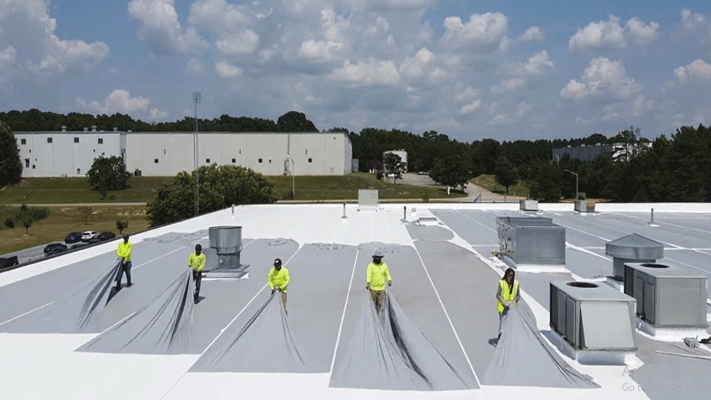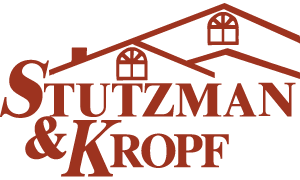In Oregon, the roof over your head needs to withstand a variety of challenges: from the relentless rain in the Willamette Valley to the heavy snowfall in the Cascades and the high winds along the coast. Depending on the style of your roof, membrane roofing in Oregon can be a standout solution, marrying durability with efficiency to navigate the state’s diverse climate. This guide delves into the world of membrane roofing, spotlighting PVC, TPO, and EPDM options, and offering insights for Oregon property owners on making the best choice for their roofing needs.
What is Membrane Roofing?
Membrane roofing involves large sheets of synthetic rubber or thermoplastic material laid out over a building’s roof to create a continuous, waterproof barrier. It’s particularly suited for low-slope or flat roofs, common in both commercial buildings and some modern residential designs. The three primary types of membrane roofing—Polyvinyl Chloride (PVC), Thermoplastic Olefin (TPO), and Ethylene Propylene Diene Monomer (EPDM)—offer distinct advantages. PVC is noted for its fire and chemical resistance; TPO for its durability, eco-friendliness, and heat-reflective properties; and EPDM for its exceptional longevity and ability to withstand extreme temperatures.

Benefits of Membrane Roofing
Membrane roofing systems are highly sought after for several reasons:
Durability and Longevity: One of the most compelling attributes of membrane roofing is its exceptional durability. Engineered to resist tears, punctures, and water infiltration, these systems can withstand the test of time against Oregon’s unpredictable weather. Membrane roofs can maintain their integrity over many years, significantly extending the lifespan of your roof and reducing the frequency and costs associated with replacements. This is particularly beneficial in regions prone to heavy rainfall and strong winds, ensuring that your property remains protected year-round.
Weather Resistance: Oregon’s climate varies dramatically, from the coastal regions battered by high winds and salty ocean air to the heavy snowfalls in the mountainous areas and the hot, dry summers of the interior. Membrane roofing systems are uniquely designed to handle these diverse conditions. Their ability to endure heavy rains, strong winds, and significant snow loads without compromising their structural integrity or water-resistance makes them an ideal choice for Oregon property owners. Whether facing a torrential downpour or a heavy snowstorm, you can trust in the robust protection offered by membrane roofing.
Energy Efficiency: In the quest for more sustainable and cost-effective building solutions, energy efficiency is a paramount concern for many Oregonians. Membrane roofing, especially reflective TPO and PVC types, addresses this need by reflecting sunlight and reducing heat absorption. This reflective capability is crucial during the warmer months, as it helps to keep buildings cooler naturally, significantly lowering air conditioning costs and overall energy consumption. Not only does this contribute to a more comfortable indoor environment, but it also aligns with environmental sustainability goals by reducing the carbon footprint of your property.
Ease of Maintenance: The maintenance of a roofing system is a critical consideration for ensuring its longevity and performance. Membrane roofs offer a distinct advantage in this area with their seamless, smooth surfaces. This design minimizes the potential for leaks and makes it easier to identify and address any issues, such as punctures or tears, should they arise. Regular maintenance tasks, such as debris removal and surface cleaning, are simplified, allowing for a more straightforward preservation of the roof’s condition. The ease of maintenance associated with membrane roofing ensures that your investment remains in top condition for years to come, protecting your property against the elements and contributing to the overall value of your building.
Applications and Uses for Membrane Roofing in Oregon
The versatility of membrane roofing makes it an excellent choice across a range of applications:
- Commercial Buildings: Its reliability and low maintenance appeal to businesses with large, flat roofs, such as warehouses and retail centers.
- Residential Properties: Homeowners who have modern architectural designs with flat or low-slope roofs can benefit from membrane roofing’s aesthetic and practical advantages.
- Specialized Applications: Membrane roofing meets the specific needs of agricultural facilities, educational institutions, and other buildings requiring durable, energy-efficient solutions.
Choosing the Right Membrane: PVC, TPO, and EPDM
In Oregon’s diverse-changing climate, selecting the right roofing material is more than a matter of aesthetics; it’s about ensuring durability, efficiency, and suitability to the specific needs of your property. Let’s delve deeper into the characteristics, benefits, and ideal applications of PVC, TPO, and EPDM roofing membranes, to help you make an informed decision.
PVC (Polyvinyl Chloride) Roofing: PVC roofing membranes are renowned for their strength, durability, and resistance to both fire and chemicals. This type of roofing material is composed of two layers of PVC material with a polyester reinforcement scrim in between, making it resistant to impact and puncture. The top layer is treated with additives that provide UV resistance and flexibility, crucial for withstanding Oregon’s varying weather conditions from the hot summer sun to the cold, wet winters. PVC’s reflective surface also helps in reducing cooling costs, making it an eco-friendly choice for energy-conscious property owners. Ideal for commercial buildings, especially those that handle chemicals or are subject to stringent fire codes, PVC roofing offers a long-lasting solution that requires minimal maintenance.
TPO (Thermoplastic Olefin) Roofing: TPO membranes combine the benefits of PVC’s durability and EPDM’s performance in a cost-effective package. They are made from a blend of polypropylene and ethylene-propylene rubber, offering excellent resistance to UV rays, ozone, and chemical exposure. TPO roofs are particularly noted for their heat-reflective properties, which can significantly lower air conditioning costs in the warmer months. This material’s flexibility makes it adaptable to a variety of roofing designs, including those with unusual shapes or numerous penetrations. Given its balance of performance, affordability, and environmental benefits, TPO roofing is a suitable choice for a wide range of applications, from large commercial facilities to residential buildings seeking a modern, efficient roofing solution.
EPDM (Ethylene Propylene Diene Monomer) Roofing: EPDM roofing is celebrated for its remarkable durability, longevity, and versatility. This single-ply membrane is made from a synthetic rubber compound, providing exceptional resistance to weathering, UV radiation, and extreme temperatures. EPDM’s elasticity allows it to expand and contract with temperature fluctuations, preventing cracking and leaking over time. Its dark color absorbs heat, which can be beneficial in cooler climates but may require additional insulation in warmer areas to maintain energy efficiency. EPDM roofing is straightforward to install and repair, making it a cost-effective choice for both new construction and retrofit projects. Ideal for buildings requiring a resilient, long-lasting roofing solution, EPDM adapts well to both commercial and residential applications in Oregon.
Membrane Roofing Installation and Maintenance
Proper installation and regular maintenance are key to extending the lifespan of a membrane roof. Your friendly roofing specialists at Stutzman & Kropf Contractors specialize in the precise installation of membrane roofing, ensuring durability and performance. Regular inspections and prompt repairs maintain the roof’s condition, protecting your property against Oregon’s weather.
Each type of membrane roofing—PVC, TPO, and EPDM—offers unique advantages that make it suitable for different applications and preferences. Whether your priority is environmental sustainability, energy efficiency, durability, or cost-effectiveness, there’s a membrane roofing solution that fits your needs. Understanding the specific benefits and applications of these materials can guide Oregon property owners to a roofing choice that offers long-term protection and performance.
By choosing Stutzman & Kropf Contractors for your roofing project, you benefit from our expertise and commitment to quality, and the fact that we are your neighbors and community partners. We are proud to work with Carlisle Syntec Systems as our preferred supplier for membrane roofing solutions.
Considering membrane roofing in Oregon? Have questions? Let’s chat. Contact us today to discuss which membrane roofing option is best suited for your property.
